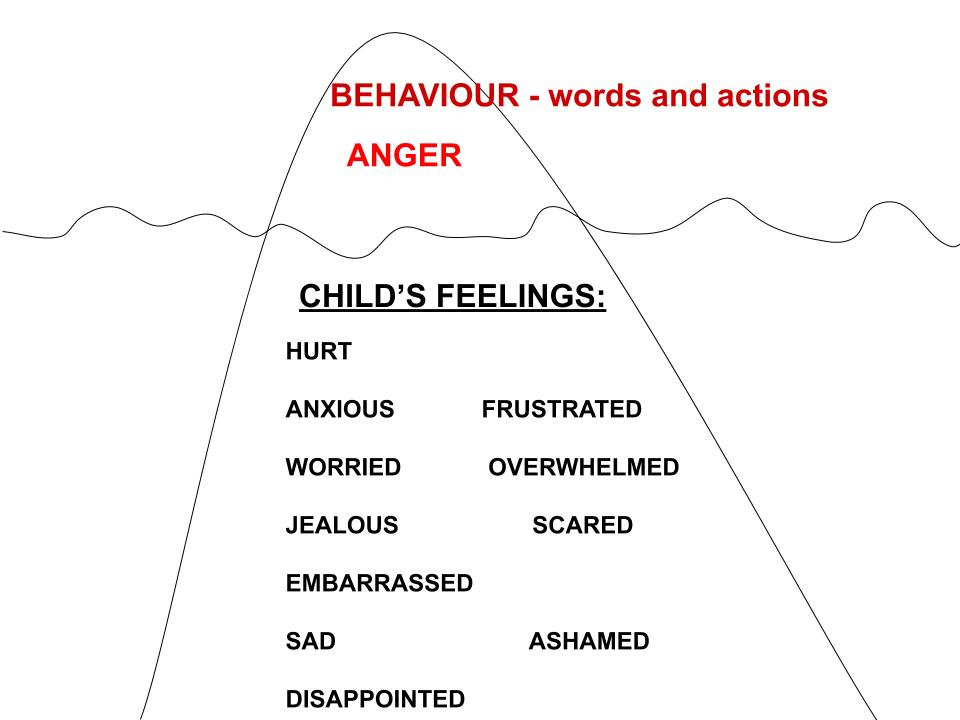
Theory of An Iceberg
One of the biggest learning concepts for me as a parent and as a counsellor, has been the importance of decoding the different types of child behaviour and our own behaviour!
In the heat of the moment, it’s easy to forget this but by having the visual of an iceberg, it can help us remember that…
“What we see on the outside is just the tip of the iceberg”
(There are many different iceberg theories out there that also add in beliefs, skills, knowledge etc. but I have chosen to hone in on our child’s behaviour and feelings.)
First, let’s take a look at the child or teen’s iceberg:

What Types of Child Behaviour or Words Do We See at The Tip of their Iceberg?
Behaviour can be outward such as:
- Physical aggression – hitting, kicking, biting, throwing things, wailing on the ground = the FIGHT response from the Amygdala part of our brain that acts on instinct when feeling threatened
- Leaving the situation – running away, bolting, storming off and slamming doors, driving away, etc. = the FLIGHT response from the Amygdala acting on instinct due to a perceived threat
or Behaviour can be inward such as:
- Withdrawal – going silent, “turtling” (going inside their shell), hiding, refusing to move = the FREEZE response from the Amygdala acting on instinct to protect the child/teen
What Words and Feelings Do We See at The Tip of the Iceberg?
- Rude words
- Disrespectful words
- Words of despair
- Rage
- Anger
- Yelling
Why is anger the only feeling at the tip of the iceberg?
Anger is a surface emotion. It’s easy to be angry and it doesn’t take vulnerability. We can get angry with complete strangers. Eg. Road rage
We don’t need a connection with someone to show that we’re angry but we do need a connection to share our more vulnerable feelings which are below the tip of the iceberg.
What Is Happening Below the Tip of The Iceberg?
Your child or teen is experiencing vulnerable feelings which is why it’s hard to share them at first.
Your child might be feeling hurt (this happens a lot for highly sensitive kids), sad, disappointed, overwhelmed, disappointed, frustrated, ashamed, jealous, scared, anxious, worried etc.
We need to try and take this opportunity to soften our child/teen and get to the feelings that our deeper in the iceberg.
I also like the symbol of an iceberg because it’s cold, sharp and icy but it can be melted. When our child is being cold, sharp and icy, we need to try to melt them. I’m sure you’ve had that experience of seeing your child go from being really harsh and angry to tears and being more soft – this is what we need to try to help them to do.
Limit Setting with Different Types of Child Behaviour
Before we talk about how to melt our child, some of you are probably wondering about limit setting. That could be another whole blog post, but the quick version, is that it depends on your child’s behaviour and your beliefs.
From my perspective, if your child is physically hurting themselves, you, a sibling or property, you need to set a limit and then get to what’s going on below the surface.
If they are using harsh words or storm off on you, then I recommend focusing on getting below the surface first and come back to the behaviour, if applicable, later.
For example, with anxiety, they go into fight, flight or freeze because they truly believe they’re under threat. It’s a physiological reaction. They’re coming from a place of fear. Punishing your anxious child is not going to change their behaviour, helping them understand their anxiety and how to manage it, is. (Read more in my free ebook: 8 Common Mistakes to Avoid When Your Child Is Anxious.)
Why focus on behaviour after?
Because in the heat of the moment, there is an opportunity to ride the wave of emotion with our child and as they come out the other side, hear their pain, and be with them in a vulnerable state. It’s a window of opportunity that might close. Later, you may or may not decide to then talk about their behaviour and making amends or doing re-pair.
How Do We Soften Our Child?
If we remember that the Amygdala part of our brain activates the fight, flight or freeze response as a protective mechanism, then we can understand that our child or teen is feeling a perceived threat or is actually threatened.
Not to compare our kids to animals, but the Amygdala part of the brain is the oldest part of our brain that we share with animals…
Imagine if you were walking in a forest and you come across a wild animal growling or hissing at you. Would you yell at it? No, you would most likely talk to it very softly, letting it know that you’re not a threat and not planning to attack.
When it comes to our children, no matter how triggered you feel (and we’ll discuss the parent’s Iceberg next week), it’s important to stay calm and let the child or teen know that you’re not planning to attack. Talk in calm voice and remember my little saying:
“Feelings First, Logics Last”
Only talk about the feelings or if that’s too vulnerable then state that you can see they’re having a “tough” time or a “difficult” day… but don’t try to rationalize with them, as they won’t hear you.
If they yell at you to “go away” (because their brain still perceives a threat), you may choose to back up and stay in the vicinity or you may walk away and give them space but come back in a few minutes (or longer depending on your child) and check-in with them.
You could say…”How are you doing?” “I’ve brought you a glass of water (or water bottle)”
It may help to use their nickname or pet name(sweetie, honey etc.) as a way to show that you are being soft. (Read more about this effective calming tip here.)
If they yell at you again to “go away”, then repeat the process until the wave of emotion finally reaches its peak and falls, at which point they should be open to you connecting with them.
During this “stay-at-home” period, there could be lots of different feelings going on deep within everyone’s iceberg, and so it is really important to not react to the tip of the iceberg but do find out what is happening at a deeper level.
Different types of child behaviour communicate different messages, but we always need to get deeper, and go below the surface. Sometimes there can also be a neurological condition and therefore it is really important to get a psycho-educational assessment to rule in or rule out neurological disorders. See my article about why I dislike the term “labelling” and the importance of data-informed assessment here.
In this blog article, I discuss what is happening at a deeper level within the parent’s iceberg, when you experience different types of child behaviour.
The more insight we have about our child’s behaviour as well as our own, leads to us being more compassionate and grounded in our response.
Take care,
Warmly,

*Registration is now open for my next round of September Brain Science online and in-person groups for children ages 7-9yrs. and 10-12yrs, to teach them about anxiety/worry and how to manage it. For more information and to register click here.
Want to Connect?
Subscribe now to receive free weekly parenting tips and inspiration.







One thought on “Types of Child Behaviour and the Deeper Meaning – Iceberg Theory”
Comments are closed.